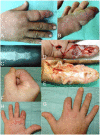Infections of Deep Hand and Wrist Compartments
- PMID: 32503146
- PMCID: PMC7356554
- DOI: 10.3390/microorganisms8060838
Infections of Deep Hand and Wrist Compartments
Abstract
The human hand is the most exposed part of the body to highest risk for injuries, loss of the skin integrity, and to the inoculation of bacteria, most commonly Staphylococcus aureus, Streptococcus β-haemolytic, and gram-negative. In case of an infection, the mobile anatomical structures and the synovial membranes in close proximity to each other may spread the pus towards deep spaces and compartments. Mild early infections without an abscess formation may respond to antibiotics, but at more advanced stage, erythema, swelling, stiffness, and severe pain may ensue. Abscess formation will cause debilitating pain, fever, systemic symptoms, and even sepsis. Necrotizing infections may threaten not only the limb, but also patient's life. Therefore, an initially "trivial" hand injury should never be neglected, as it might turn into a deep space infection, which must be treated immediately with drainage, wound debridement, and i.v. antibiotics. Delay in diagnosis and inadequate initial management might rapidly lead to abscess formation, destruction of the gliding surfaces and the normal anatomy, and irreparable functional deterioration.
Keywords: Parona’s space; hand and wrist compartments; hand infection; necrotizing fasciitis; pyogenic flexor tenosynovitis; septic arthritis.
Conflict of interest statement
The authors declare no conflict of interest.
Figures








Similar articles
-
Septic arthritis of the wrist: A case of Parona space abscess in a rheumatoid arthritis patient with Charcot wrist.Radiol Case Rep. 2024 Jul 24;19(10):4248-4254. doi: 10.1016/j.radcr.2024.05.009. eCollection 2024 Oct. Radiol Case Rep. 2024. PMID: 39135673 Free PMC article.
-
Deep subfascial space infections.Hand Clin. 1998 Nov;14(4):557-66, viii. Hand Clin. 1998. PMID: 9884894 Review.
-
Hand infections: anatomy, types and spread of infection, imaging findings, and treatment options.Radiographics. 2014 Nov-Dec;34(7):1968-86. doi: 10.1148/rg.347130101. Radiographics. 2014. PMID: 25384296 Review.
-
[Infections of the hand].Orthopade. 1988 Feb;17(1):89-95. Orthopade. 1988. PMID: 3374959 German.
-
An experimental analysis of the curative action of penicillin in acute bacterial infections. III. The effect of suppuration upon the antibacterial action of the drug.J Exp Med. 1956 Apr 1;103(4):509-22. doi: 10.1084/jem.103.4.509. J Exp Med. 1956. PMID: 13306859 Free PMC article.
Cited by
-
Case report: Abscesses in children caused by invasive group A Streptococcus.Front Med (Lausanne). 2024 Aug 9;11:1438624. doi: 10.3389/fmed.2024.1438624. eCollection 2024. Front Med (Lausanne). 2024. PMID: 39185468 Free PMC article.
-
Neonatal Deep Palmar Space Infection: An Unusual Presentation.Cureus. 2023 May 6;15(5):e38626. doi: 10.7759/cureus.38626. eCollection 2023 May. Cureus. 2023. PMID: 37284368 Free PMC article.
-
[Impact of the COVID-19 pandemic context on the microbiological epidemiology and management of flexor sheath phlegmons].Revue de chirurgie orthopedique et traumatologique. 2023 Feb;109(1):48-53. doi: 10.1016/j.rcot.2022.05.002. Epub 2022 May 12. 2023. PMID: 35578603 Free PMC article. French.
-
Septic arthritis of the wrist: A case of Parona space abscess in a rheumatoid arthritis patient with Charcot wrist.Radiol Case Rep. 2024 Jul 24;19(10):4248-4254. doi: 10.1016/j.radcr.2024.05.009. eCollection 2024 Oct. Radiol Case Rep. 2024. PMID: 39135673 Free PMC article.
-
Polymer-Based Constructs for Flexor Tendon Repair: A Review.Polymers (Basel). 2022 Feb 23;14(5):867. doi: 10.3390/polym14050867. Polymers (Basel). 2022. PMID: 35267690 Free PMC article. Review.
References
-
- Belcher H.J.C., Clare T.D. Hand infections. Curr. Orthop. 2003;17:28–43. doi: 10.1054/cuor.2002.0318. - DOI
-
- Afrăsânie V.A., Adavidoaiei A.M., Zamisnicu I.H., Funingănă I.G., Marinca M.V., Gafton B., Clement D.E., Păduraru M.I., Demşa I., Miron L., et al. A very rare presentation of lung cancer: Metastases to the distal phalanx of index-case report. Medicine. 2019;98:e17892. doi: 10.1097/MD.0000000000017892. - DOI - PMC - PubMed
-
- Szabo R.M., Spiegel J.D. Infected fractures of the hand and wrist. Hand Clin. 1988;4:477–489. - PubMed
LinkOut - more resources
Full Text Sources

